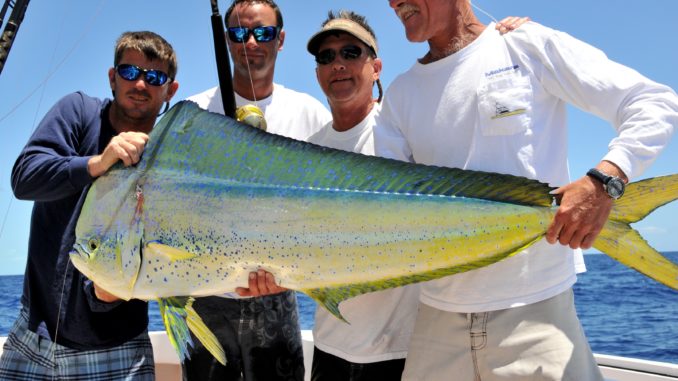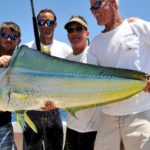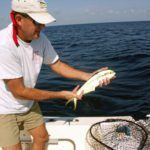
Exceptionally low numbers of young dolphin point to disappointing 2017
A sharp decline in the number of young dolphin showing up along the coasts of North and South Carolina this year has charter captains and scientists wondering if fishing for the highly-prized sport fish will be boom or bust in 2017.
The alarm was raised by marine biologist Don Hammond, who has run the Dolphinfish Research Program out of Charleston for the past 15 years since retiring from the S.C. Department of Natural Resources. Hammond is concerned that 2017 may be the acid test for the dolphin fishery along the Southeastern coast.
“The 2016 spring dolphin fishing season along the U.S. East Coast arrived early and featured some excellent fishing for 15-to 25-pound fish, but was rather abbreviated except off North Carolina,” Hammond wrote in the October DRP Newsletter. “The scary part of the 2016 season was that the young-of-the-year (YOY) school fish did not show up in good numbers after the gaffer dolphin had left.”
Hammond explained that normally the YOY fish flood into the area after the larger dolphin have left. Large schools of the voracious little fish provide fun and excitement for anglers and sustain charter boat fishing from southeastern Florida to the Outer Banks of North Carolina throughout the summer.
Hammond’s concern is backed up by the experiences this year of charter boats off the Carolinas.
“Our dolphin fishing out of Charleston this year was almost all gaffers,” said Capt. Bobby Krivohlavek, who fishes The Day Maker out of Shem creek. “We did not have a lot of small ones and I don’t know if it was a lack of small dolphins or if they were just not where we were fishing.”
Krivohlavek said he did find plenty of small dolphins off Oregon Inlet in North Carolina and Virginia Beach. But many of the dolphins he caught this year were not healthy fish.
“Our biggest concern this year was we were catching a lot of dolphin that were sickly and had a lot of parasites in them. They were unhealthy looking fish, skinny with red eyes. That is the first time we’ve caught that many unhealthy fish.”
Capt. Rom Whitaker who fishes The Release out of Hatteras Village said he has not seen many small dolphin off Hatteras for the past two years.
“Normally, June, July and August is when we catch ‘bailer’ fish, but our good ‘bailer’ fishing came late last year – September and October. This year, although I won’t say it is non-existent, it is really slow.”
The low numbers of small dolphin has been consistent up and down the migratory range of the fish, from the Gulf of Mexico up along the East Coast, Hammond said, and that could have ominous consequences for the 2017 dolphin fishing season. Dolphin are rapidly-growing fish that can attain a length of over 4 feet in the first year of growth, and up to 6.5 feet in four years. The tagging program Hammond runs saw a precipitous drop in the number of YOY fish tagged this year, with fewer fish tagged than in any previous year since the first year of the program when it was just getting underway.
“The critical issue,” Hammond said, “is that these YOY fish form the population segment that is responsible for the spring gaffer dolphin along the U.S. Atlantic and Gulf coasts the next year. Without a strong run of YOY fish this year, what kind of fishing season will we see next year?”
Hammond fears some catastrophic event has killed an entire year class of fish and it may be devastating to dolphin fishing in 2017. He pointed to the latent effects of the 2010 Deep Water Horizon disaster which spilled more than 3 million barrels of crude oil into the Gulf of Mexico, a major nursery area for dolphin and many other important fish.
Both the crude oil and the dispersant used to dilute it have been proven to be toxic to fish, he said. A study by scientists at the University of California Riverside and the University of Miami Rosenstiel School of Marine and Atmospheric Science found that ultraviolet light increases the toxicity and damages the heart, eye and neurological function of fish larvae.
Hammond said the best case scenario would be that the low numbers are the result of some subtle change in North Atlantic ocean currents that threw the YOY migration off this year and there could be a return of strong numbers of gaffer fish and YOY dolphin next year.
“We don’t know anything about them in the 6,000-mile trip they make each year in the open Atlantic Ocean and the Sargasso Sea. There could be a phenomenal population of fish out in that area that we don’t know about and we could wind up having a banner season next year.”
If not, the result could be a major blow to the coastal economy of both states, Hammond said.
“My work shows that offshore anglers fish far more when the dolphin are biting. Each year when the dolphin disappear, offshore anglers stop or radically reduce the number of fishing trips. Without the spring dolphin run there could be a major economic loss to the coastal economy.”
“The dolphin are our bread and butter,” said Capt. Whitaker. “From May to September it is our No. 1 caught fish. It concerns me when we don’t see them.”




